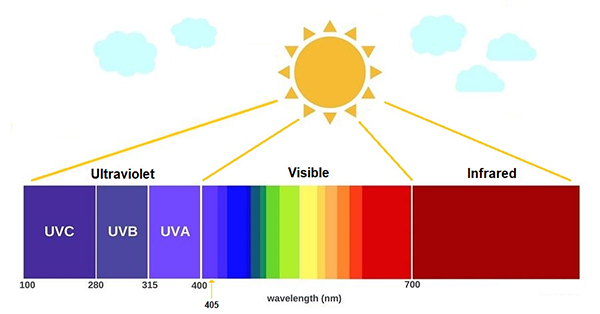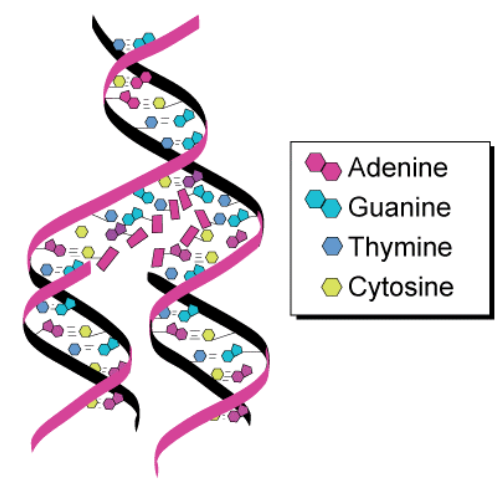What is UV Light?
Within the spectrum of sunlight, the light with a wavelength of 100 to 400 nanometers (nm) is called ultraviolet light. It can be divided into UV-A (315 to 400 nm), UV-B (280 to 315 nm), and UV-C (200 to 280 nm).
Unlike with regular fluorescent light tube products, which allow us to visually confirm light brightness, assessing light intensity on a UV lighting device is more complicated, as UV light is invisible to the naked eye.
UV-C light does not fall on ground of the earth as it it blocked by ozone, so it is generally prepared artificially.
UV-C light falls between 200 and 280 nm (peak at 250-275 nm) and bears the ability to kill pathogens. Also known as germicidal light, this UV range includes far-UV-C radiation (207 to 222 nm) and UV-C radiation.


How does UVC work?
Research has shown that DNA (deoxyribonucleic acid) and RNA (ribonucleic acid) absorb ultraviolet radiation most readily at wavelengths between 254 and 275 nm. Since UV-C falls within this range, UV-C technology is capable to penetrate the cell membrane and nucleus of pathogens.
When the DNA and RNA in the cells of a pathogen are exposed to UV-C radiation, a chemical change occurs in the nucleic acids, resulting in a corruption in the genetic code. During this process, called dimerization, UV-C radiation inactivates the pathogen by causing cellular inability to regenerate or replicate, or by causing cell death.
Due to this ability, UV-C light is also known as germicidal UV, and has been proven to successfully neutralize the effect of a variety of pathogens, such as bacteria, spores, viruses, fungi, etc.

What benefits are available when UVC is used?
• Effective Germicidal Wavelength
• Effective Eradication of Most Spores
• Covering Large Production Capacity of UV-C light disinfection.
• UV treatment is highly compatible with other treatment processes
• Cost effective, low initial capital costs and reduced operating costs
• No side effect of anti-biotic or anti-drug
• No rough handling and no need of professions in chemical preparation and storage
• Flexible design capabilities for custom lamp system development
• Equipment with wide operating temperature
• Environmentally friendly, no dangerous or toxic chemicals on the air or water, no harmful residual
• Easy to work with controls such as PIR, infrared, radar, APP, computer, DALI, LoRa, IoT, blue tooth, 0-10V
Frequently asked questions
Q:What is ultraviolet germicidal irradiation and how does it work?
A:UVC radiation with a specific wavelength emitted by a germicidal lamp breaks and destroys the chains of DNA and RNA of micro-organisms, rendering them unable to grow or reproduce, which in turn leads to the death of the colony.
Q: Can UVC light be used for general lighting purpose?
A: No, UVC light shall never be used for lighting purpose. The human exposure to UV shall be strictly followed by ACGIH requirement.
Q: Can UVC 253.7nm be used on human body?
A:No. UVC with 253.7nm is very harmful for human health when being exposed. So it is used in area where people or livestock is not present.
Q: What are the pros of UVC irradiation?
A:It is a physical disinfection with high efficiency and kills almost all known virus with no chemical residual in an odorless way.
Q:Which is more friendly to human, UVC 222nm or UVC 254nm?
A:UVC 222nm is more friendly to human. Studies have shown that wavelengths at 222nm are absorbed by the top layer of the skin, not penetrating deeper into epidermis, causing sunburn or skin cancer. These wavelengths are also potentially safe for eyes with the light being completely absorbed by the cornea, leaving the rest of the eye undamaged.
Q: What safety precautions should be taken when servicing germicidal UVC?
A:The Germicidal UVC device shall be grounded electrically. No human or livestock shall be exposed to UVC light. The power shall be turned off before servicing work which can be done only after the lamp and device are cooled down completely. Do not try to service lamp or ballast. Consult a manufacturer’s representative if needed. Wear PPE during maintenance or operation. Read manufacturer’s instruction manual before servicing. Follow all local, national and international safety regulations on UVC.






 Min ICP 2022003414-1
Min ICP 2022003414-1